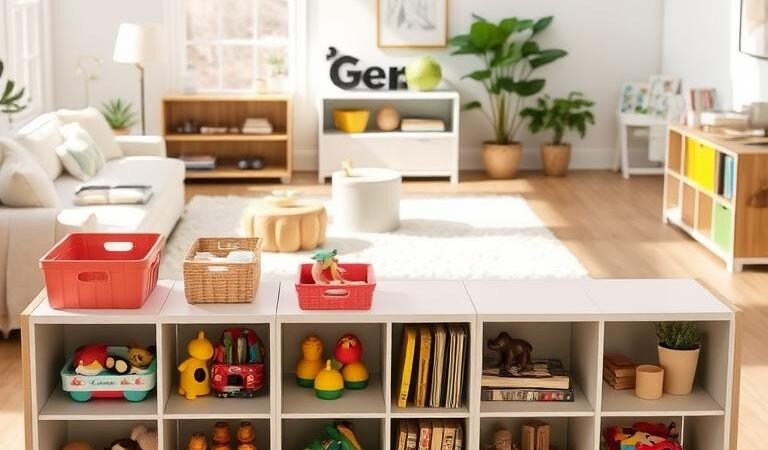Modern homes often serve multiple purposes—especially in busy households. The challenge? Keeping spaces stylish while managing everyday clutter. Families across the U.S. are embracing smart solutions that blend function with design.
From built-in bookshelves with hidden compartments to under-furniture bins, creative approaches make all the difference. A North Carolina family transformed their space using IKEA systems and textured baskets—proving practicality can meet elegance.
This guide shares 12 expert-approved strategies to maintain a polished look without sacrificing comfort. Learn how color-coded systems, multi-functional coffee tables, and seasonal rotations keep chaos at bay.
Key Takeaways
- Dual-purpose furniture maximizes space efficiently
- Built-in shelving offers hidden storage opportunities
- Color-coding simplifies organization for families
- Textured baskets add warmth while concealing items
- Rotating toys seasonally reduces visual clutter
Why Toy Storage in the Living Room Matters
Clutter-free spaces promote mental clarity—especially in shared areas. A 2023 study revealed that adults in organized living rooms reported 40% lower stress levels. When toys blend seamlessly into the decor, families enjoy both play and relaxation without visual overwhelm.
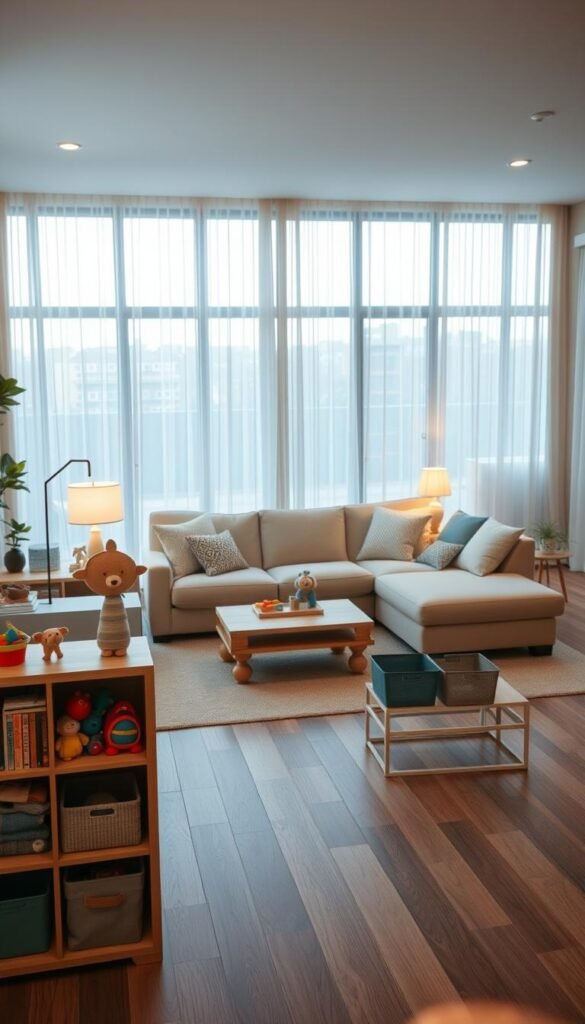
For homes without playrooms, spatial efficiency is key. A 20′ family room in Seattle doubled as a play zone using a floating sofa—creating distinct “zones” for adults and kids. Durable PPG Break-Through! paint protected floors from stray crayons, proving practicality meets style.
Safety matters in mixed-use areas. Open bins encourage independence but concealed storage reduces tripping hazards. Textured baskets add warmth while keeping small parts out of reach—a win for aesthetics and childproofing.
Shared spaces teach valuable lessons. Accessible shelves let toddlers practice organization, turning cleanup into a game. This family-first design philosophy nurtures responsibility while maintaining a polished look.
Whether opting for open cubbies or closed cabinets, the goal is harmony. A well-planned space adapts to daily life, proving that functionality and beauty coexist effortlessly.
1. Use “Real” Furniture to Hide Toys
Functional design hides clutter without sacrificing style. Built-in shelves and multi-purpose pieces blend seamlessly into adult spaces while keeping kid essentials accessible. The trick? Choosing pieces that look intentional—not like afterthoughts.
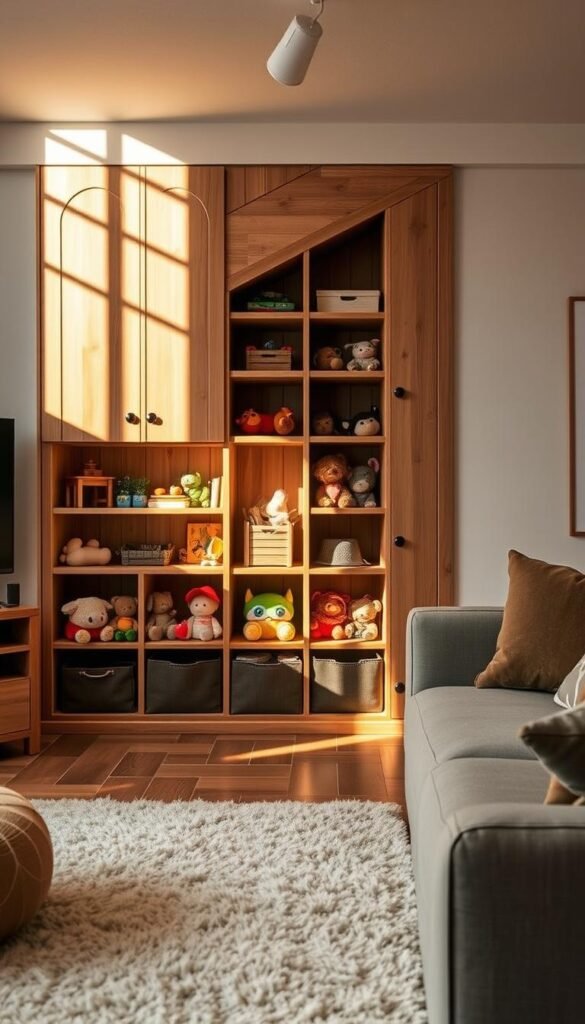
Shelves Behind Close-able Doors
Lower cabinets in bookcases transform into hidden storage for toys. A Chicago family lined theirs with playful wallpaper—visible only when doors swing open. For safety, avoid overstuffing; keep shelves 70% full to prevent strain.
Door materials matter:
- Wood: Classic and soundproof
- Glass: Lets kids spot favorite items
- Fabric inserts: Softens sharp edges
Open Shelves with Decorative Baskets
Textured baskets add warmth while corralling small items. Follow the 3:1 rule—three neutral bins for every colorful one. Use the front 6″ of shelves for display, tucking clutter deeper (“deception depth”).
IKEA Kallax systems shine here. Pair them with canvas bins for a modern look or woven options for rustic charm. Labeling each container speeds cleanup.
Furniture with Built-In Storage
Armoires and consoles retrofit beautifully. Add adjustable shelves to accommodate bulky toys or board games. A New York designer converted a mid-century credenza into a art-supply hub by adding sliding trays.
Maintenance tip: Rebalance shelf weights quarterly to prevent sagging. Rotate seasonal items to keep the space fresh.
2. Create Dedicated Play Zones
Smart zoning transforms chaotic areas into purposeful spaces. Define an activity radius tailored to your child’s age—toddlers thrive in 3’–4′ zones, while older kids need 5’–6′ for crafts or building. A Minnesota family carved out a 5′ art station using a wall-mounted easel and pegboard for supplies.
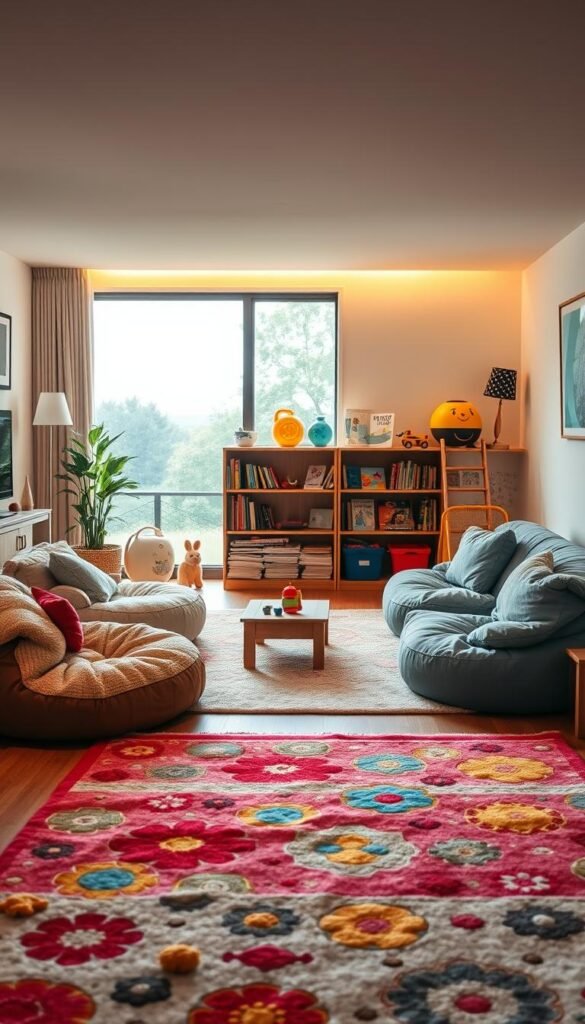
Clear acrylic jars keep markers and crayons visible yet contained—ideal for quick cleanup. Research shows labeled storage boosts kids’ independence by 30%. Pair them with low shelves for a self-service setup.
Flooring defines zones effortlessly. Plush rugs soften play areas, while interlocking foam mats cushion tumbles. For open-concept rooms, a jute rug anchors the adult seating area, creating visual separation.
Anchor zones with pendant lights or bold rugs. IKEA’s Trofast system—with its slide-out drawers—keeps toys contained but accessible. Arrange zones diagonally across the room to improve traffic flow and prevent bottlenecks.
Bookcase room dividers offer acoustic separation and extra storage. Safety-proof zones with corner guards and outlet covers. Rotate activities seasonally—swap a LEGO table for a winter reading nook—to maintain excitement and order.
3. Opt for a Hard-Surface Coffee Table
Hard-surface coffee tables bring durability and style to active households. Unlike fabric ottomans, these tables resist stains and provide stable workspaces for crafts or snacks. Their flat tops also make cleanup effortless—just wipe away marker streaks or glitter spills.
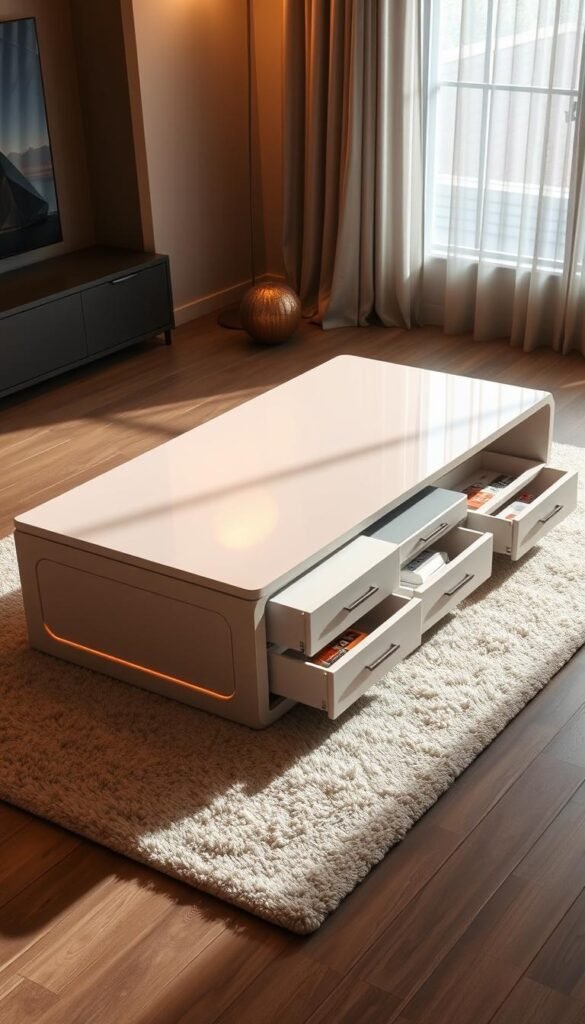
Benefits Over Storage Ottomans
Sturdy tables handle heavy use better than padded alternatives. Granite tops support up to 150 lbs—ideal for climbing toddlers—while wood offers warmth and scratch resistance. Acrylic models impress with lightweight strength and modern transparency.
Matte finishes hide fingerprints better than glossy surfaces, especially during daily LEGO builds. For families, rounded corners with 1″+
radii prevent injuries during play. The Esmont Large Coffee Table earns praise for its kid-safe edges and hidden lift-top compartment.
Top Picks for Family-Friendly Tables
Look for these smart features when shopping:
- Sliding trays: Access items without lifting the entire top
- Color-blocked organizers: Assign zones for crayons, books, and small things
- 18″ height: Matches standard sofa seating depth
Wirecutter’s clever hack: Convert any table into an activity center by adding non-slip drawer liners. For stools that tuck underneath, allow 7″ clearance from the floor. Tackle stains promptly with baking soda paste for wax or rubbing alcohol for ink.
4. Stylish Baskets and Bins for Open Storage
Open storage solutions blend accessibility with design flair. Textured bins and woven baskets turn everyday items into decorative elements while keeping essentials within reach. This approach works especially well for homes where quick cleanup matters.
Canvas vs. Woven: Which Works Best?
Canvas storage bins offer durability with options like 600D or 900D denier fabric. They resist stains and handle up to 8 lbs per handle. Handled pantry bins work well for small items like LEGO bricks or art supplies.
Woven choices bring natural texture. Seagrass withstands daily use, while water hyacinth adds organic charm. For high-traffic areas, pair them with rug pad liners to prevent slipping. Follow the 1:3 size rule—one large basket for every three small ones—to create visual balance.
Labeling Tips for Easy Cleanup
Clear labels empower kids to tidy independently. Flashcard tags with D-ring clips attach easily to bins. For durability, iron-on vinyl outperforms chalkboard tags in busy households.
Monthly maintenance keeps systems fresh. Vacuum baskets to remove dust and rotate nested bins seasonally. Avoid overloading—distribute weight evenly to preserve handles and structure.
For more creative solutions, explore these toy organizer ideas that combine function with style.
5. Repurpose Built-In Shelves for Toys
Industrial pipe shelving brings rugged charm while solving storage challenges. Beneath My Heart’s DIY project showcases iron pipes with wooden planks—perfect for holding bins of things while adding urban flair. The warm patina develops over time, blending with both modern and rustic decors.
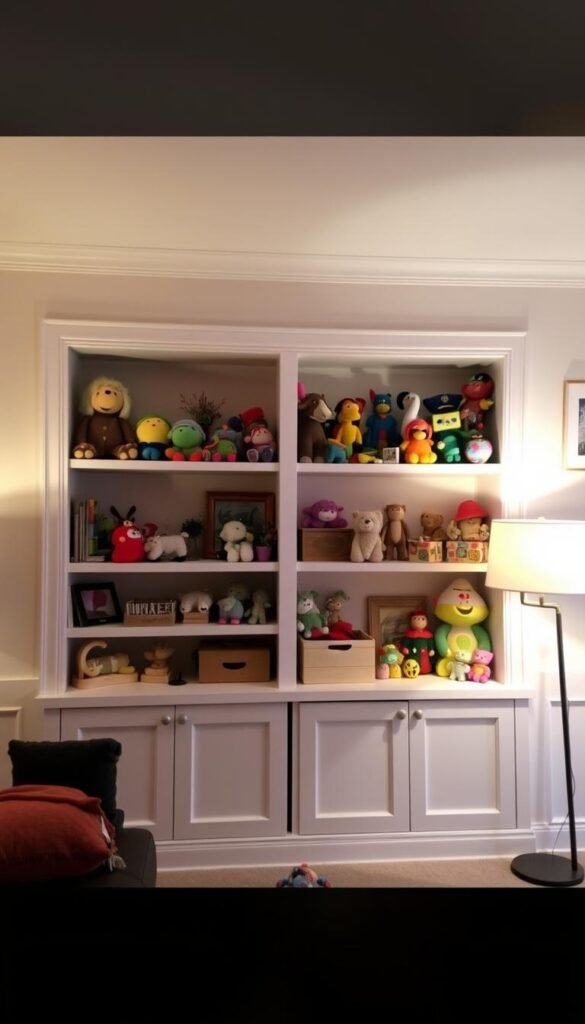
Modify existing shelves by adjusting depths to 12″ for optimal use. This crisp measurement fits standard bins while leaving room for display items at the front. Use tension rods vertically to create compartments—ideal for separating puzzles from art supplies without bulky dividers.
Protect plastic items by positioning them away from direct sunlight. UV rays cause fading and brittleness over time. Adhesive safety strips along edges prevent bumps during active play, especially important in high-traffic areas of the home.
The “display forward” technique keeps frequently used items accessible. Place favorite books or games in the front 6″, with less-used pieces behind. Picture rails mounted below shelves hold small fabric bins—great for corralling action figures or doll accessories.
For mixed-age families, create dual-height arrangements. Lower sections (18″ from floor) suit toddlers, while upper areas (36″+) store older kids’ projects. Quarterly checks ensure shelf anchors remain secure, especially important in earthquake-prone regions.
Remember to distribute weight evenly across brackets. Overloading one side causes sagging—keep loads under 15 lbs per linear foot for most materials. This smart approach maximizes space while maintaining structural integrity for years of use.
6. Under-the-Furniture Storage Solutions
Unused spaces beneath furniture hold surprising potential for clutter control. These often-overlooked zones transform into functional storage areas when equipped with the right systems. From beds to sofas, strategic utilization maximizes every square inch.
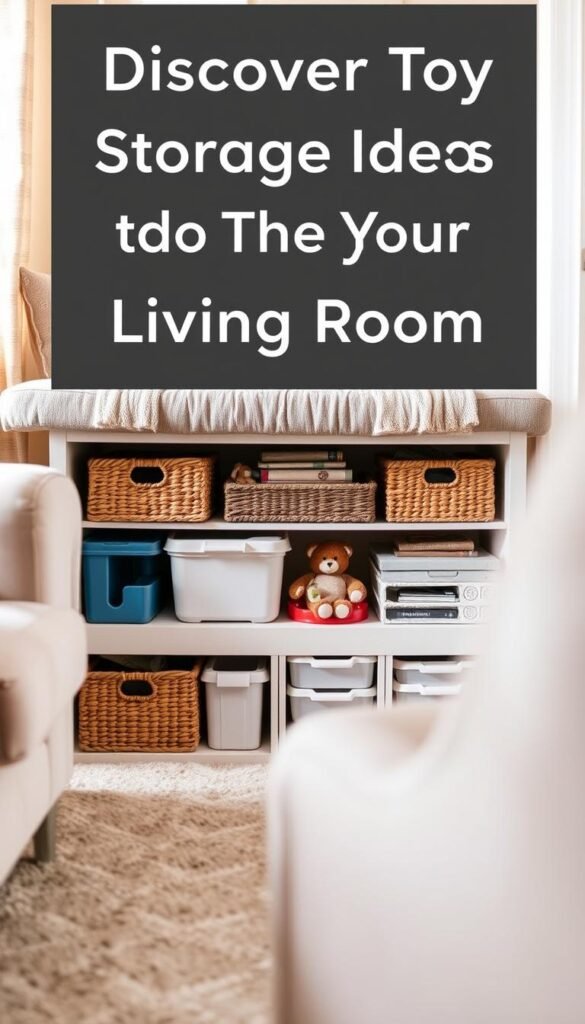
Beds with Drawers
Annie Schlechter’s bunk bed design showcases space-saving genius with full-extension drawers. These glide smoothly on premium rails, holding up to 50 lbs of seasonal clothing or bulky items. For easier access, choose slide-out mechanisms over lift-up styles—especially important in tight spaces.
Measurement hacks simplify planning. Pizza boxes make perfect templates for under-bed bins. IKEA’s storage bags fit standard frames while protecting contents from dust. Upgrade basic plastic bins with castor wheels for effortless movement across hardwood floor.
Low-Profile Bins for Sofas
Most sofas need 6″ clearance for proper air circulation—the ideal height for slim organizers. Felt-lined bins prevent scratches while corralling remote controls or magazines. Label the underside of lids for discreet organization that maintains clean lines.
Avoid fabric bins in high-dust areas; they trap allergens over time. Instead, opt for wipe-clean materials with tight-weave construction. For sectional sofas, custom-cut plywood platforms create stable bases for multiple bins while distributing weight evenly.
7. Wall-Mounted Storage for Small Spaces
Vertical surfaces offer untapped potential for creative organization. In space-challenged homes, walls become functional canvases that keep floors clear. This approach works particularly well for art supplies and frequently used items.
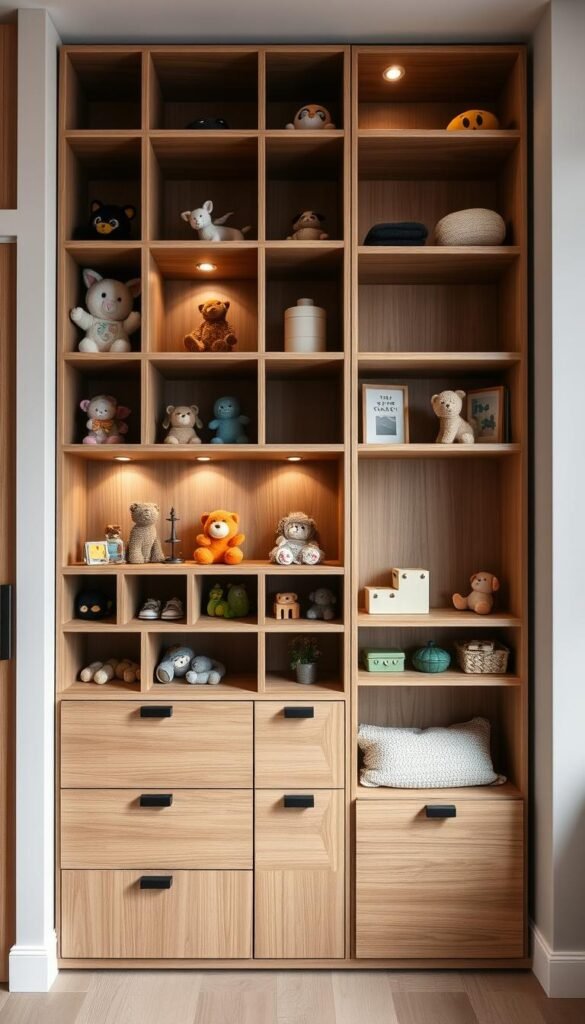
Peg Rails and Hanging Baskets
Steel pegboards handle up to 25 lbs per square foot—ideal for heavy storage needs. Composite options provide warmth with maple or walnut finishes. A Brooklyn mom’s genius hack combines both: steel backing with wooden pegs for mixed-load capacity.
Consider these installation tips:
- Schaller hardware distributes weight evenly across studs
- Removable wallpaper backdrops add personality to plain panels
- UV-protective spray preserves fabric baskets from sun damage
For earthquake zones, use toggle bolts instead of plaster anchors. Position rails 36″ from the floor for child access—this height lets toddlers reach while preventing climbing.
Cubbies for Art Supplies
A Cup of Jo’s craft wall demonstrates smart “activity clusters.” Locker baskets with chalkboard fronts label materials while adding texture. The system groups markers, paper, and glue sticks in separate cubbies—streamlining creative sessions.
Key measurements for success:
- 6″ depth prevents supplies from toppling forward
- 3″ spacing between cubbies allows easy bin removal
- 18″ width accommodates standard construction paper
Rotate displayed items monthly to maintain interest. For rented spaces, adhesive hooks hold lightweight bins without damaging walls. This vertical approach turns any blank wall into a functional art station.
8. Multi-Functional Kids’ Furniture
Innovative kid-friendly furnishings merge play and practicality seamlessly. These adaptable pieces grow with families, offering clever organization solutions that withstand years of use. From modular systems to convertible benches, smart designs maximize space while encouraging independence.
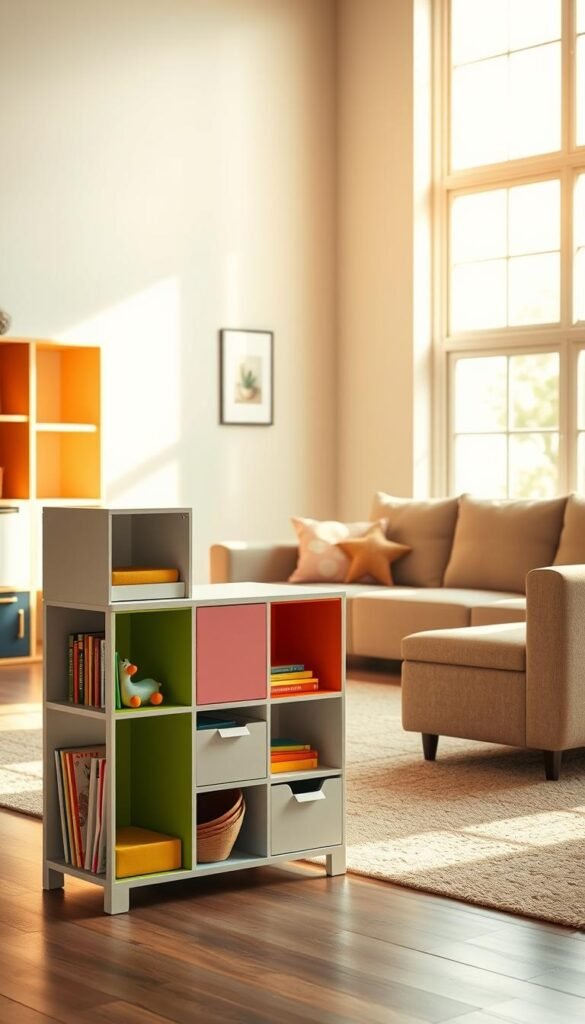
IKEA Trofast and Kallax Systems
The Trofast series shines with its interlocking plastic bins and sturdy pine frames. Customizable configurations accommodate everything from dress-up costumes to building blocks. Sawyers family reports their unit remained sturdy through a decade of daily use—proof of smart engineering.
| Component | Measurement | Weight Capacity |
|---|---|---|
| Small bin | 13″ x 10″ x 5″ | 8 lbs |
| Large bin | 21″ x 15″ x 6″ | 12 lbs |
| Frame rail | 28″ length | 30 lbs distributed |
Kallax units gain mobility with castor kits (sold separately). These wheeled bases transform shelving into movable activity centers. For arts-and-crafts stations, add pegboard inserts to the back panels—creating vertical storage without floor space sacrifice.
DIY Storage Benches
Maison de Pax’s crate shelving demonstrates how basic materials become stylish solutions. Plywood platforms over Trofast units create instant play tables with hidden drawers. Follow these guidelines for bench conversions:
- Use 1.5″ foam for seat cushions—thick enough for comfort but slim for proportion
- Attach non-slip rug pads to prevent shifting during active play
- Allow 1″ clearance around bins for proper ventilation
Seasonal rotations keep these systems fresh. Store off-season items in labeled storage bins beneath the bench seat. This approach maintains visual calm while keeping favorites accessible. For dress-up stations, mount curtain rods inside cabinets for hanging costumes—saving precious shelf space.
Remember: Over-tightening Trofast rails can warp the frame. Hand-tighten screws until snug, then stop. Quarterly checks ensure hardware remains secure without compromising the wood’s integrity. These thoughtful touches create furniture that works as hard as your family does.
9. Color-Coded Toy Organization
Strategic color systems bring harmony to busy spaces. When toys and supplies follow a chromatic logic, cleanup becomes intuitive—even for young children. The Say Yes blog’s acrylic cylinder display proves this, sorting LEGO bricks into radiant columns that double as decor.
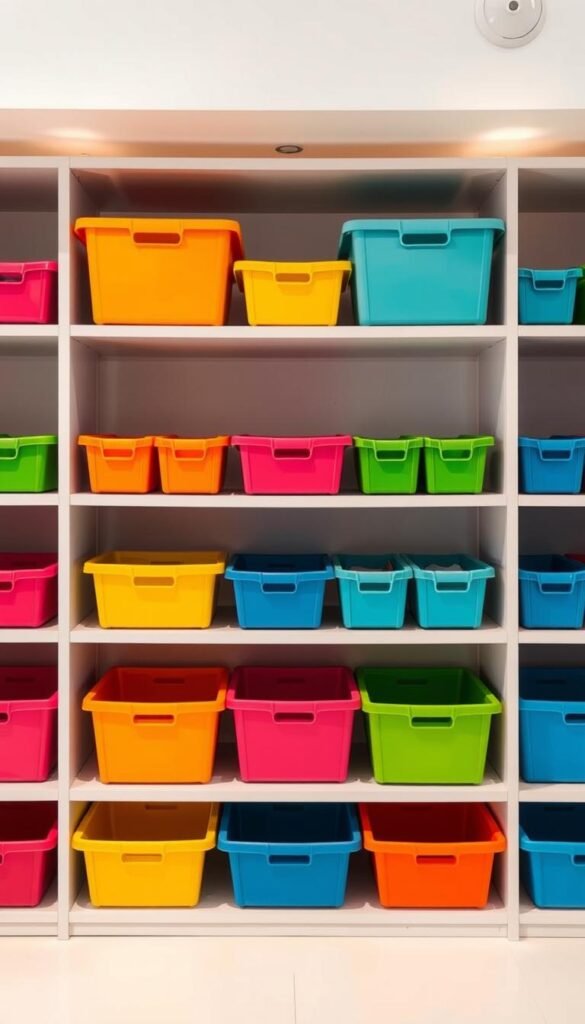
Not all color systems work equally well. Consider these professional-grade options:
| System | Best For | Maintenance |
|---|---|---|
| Pantone | Precision matching | Monthly color calibration |
| Munsell | Nuanced hues | Seasonal adjustments |
| Basic rainbow | Quick identification | Weekly sorting |
Light reflectance values (LRV) matter for bins. Choose 50+ LRV for dark rooms—it makes labels pop. In sunlit areas, 30-40 LRV prevents glare while maintaining visibility.
Turn cleanup into games with color challenges:
- “Beat the clock” races matching red items
- Rainbow scavenger hunts
- Color-coded chore charts
Dyslexia-friendly combinations improve accessibility. Avoid red/green pairings—opt for blue/yellow instead. The Cleveland Clinic recommends 70% contrast between labels and containers.
Color psychology enhances play spaces. Soft blues promote calm in reading nooks, while vibrant oranges energize craft areas. Rotate accent hues seasonally to maintain interest without overwhelming.
Prevent over-sorting—group by category first, then color. Monthly “color audits” keep systems functional. Wipe down bins with matching microfiber cloths to prevent dye transfer.
10. Rotate Toys Seasonally
Thoughtfully rotating children’s belongings aligns with developmental stages and seasonal activities. This method prevents overwhelm while keeping play engaging—studies show kids focus 40% longer on toys reintroduced after a break. Wirecutter’s genius hack? Labeled bins with color-coded lids streamline the process.
- Basement dehumidifiers maintain 50% humidity for wooden puzzles
- Bedroom closets (upper shelves) for easy quarterly swaps
- Under-stair cubbies with cedar blocks to deter moths
Skip the attic—those summer temperatures warp plastic. For delicate items like stuffed animals, silica gel packets prevent moisture damage. Photograph things before storing; this aids insurance claims and helps kids remember what’s coming back.
Time rotations with school schedules—donate outgrown items before winter break when charities need them most. Keep memory boxes separate, labeling them with dates rather than contents. This preserves nostalgia without cluttering active space.
11. Utilize Vertical Space
From floor to ceiling, smart homeowners are discovering the untapped power of upward organization. Walls and unused vertical areas become valuable real estate when equipped with the right storage solutions. This approach works particularly well in compact spaces where every inch counts.
Over-the-Door Organizers
Doors transform into functional spaces with clever hanging systems. Mesh organizers offer breathability for frequently used items, while canvas versions provide sturdier pockets for heavier objects. Country Living’s pass-through cubbies add versatility—items can be accessed from either side.
Consider these installation tips:
- Use door stops to prevent organizers from catching when closing
- Limit pocket capacity to 50% to avoid seam stress
- Tension rod curtains disguise contents while maintaining accessibility
For earthquake safety, secure tall units with straps anchored to wall studs. The IKEA ENHET system shines here—its modular components adapt to various door widths and storage needs.
Tall Bookcases with Lower Toy Storage
Floor-to-ceiling units maximize shelves while keeping children’s items within reach. Implement “activity height zoning”—place frequently used toys on lower levels (18″-36” from floor) and display items higher up. This preserves adult sightlines while encouraging kid independence.
Safety comes first with tall furniture:
- Anchor bookcases to walls with anti-tip hardware
- Maintain 3:1 weight ratio—heavier items on bottom shelves
- Use felt pads under decorative objects to prevent sliding
Ladder protocols matter too. Teach children proper climbing techniques and limit access when unsupervised. The result? A room that flows beautifully from floor to ceiling, with every level serving its purpose.
12. Involve Kids in the Organization Process
Teaching children organizational skills early fosters independence and reduces cleanup stress. Simple systems empower little ones to participate while making storage solutions work for the whole family. The key? Designing methods that match their developmental stage.
Child-Friendly Labeling Ideas
Visual cues help pre-readers navigate organization systems effortlessly. Try these approaches:
- Symbol-based tags: Pair pictures (blocks, dolls, cars) with words for gradual reading practice
- Chalkboard labels: Let kids customize bins with seasonal drawings using non-toxic chalk markers
- Color-coded dots: Match container colors to toy categories for instant recognition
Height matters when placing labels. Position them 24″ from the floor for toddlers and 36″ for elementary-aged kids. The IKEA Tolsby frame doubles as a wipe-clean label holder—perfect for rotating categories.
| Age Group | Label Type | Placement Height |
|---|---|---|
| 2-3 years | Large symbols | 18″-24″ |
| 4-6 years | Symbol + word | 24″-36″ |
| 7+ years | Text-only | 36″-48″ |
Reward Systems for Tidy Habits
Positive reinforcement builds lasting habits. A magnetic star board tracks progress—each completed cleanup time earns a colorful marker. Research shows immediate rewards work best for young children.
Try these motivational strategies:
- 5-minute tidy songs: Upbeat music signals cleanup time while making it fun
- Weekly “treasure chest” draws for consistent helpers
- Progress charts with non-food rewards (extra storytime, park visit)
Avoid over-complex systems. The KISS method (Keep It Simple, Sweetie) works best for busy families. Rotate rewards monthly to maintain excitement without creating entitlement.
Remember—participation matters more than perfection. Praise effort with specific compliments like “You matched all the blocks to their pictures!” This builds confidence while reinforcing the organization system.
Conclusion
Creating harmony between play and relaxation is possible with smart design choices. Families nationwide prove that zoning techniques, vertical solutions, and seasonal rotations maintain order without sacrificing style.
Start small—perhaps with labeled baskets or a dual-purpose coffee table. Many find that implementing just two strategies cuts cleanup time by half. The Minnesota family mentioned earlier reduced clutter stress by 60% using these methods.
For those needing extra space, consider garage storage for seasonal items. Our upcoming guide on outdoor organization will explore this further. Meanwhile, download our free checklist to track progress room-by-room.
Remember: Great design nurtures both children and adults. With thoughtful planning, any home can balance function and beauty effortlessly. Seasonal refreshes keep systems working smoothly as kids grow.
